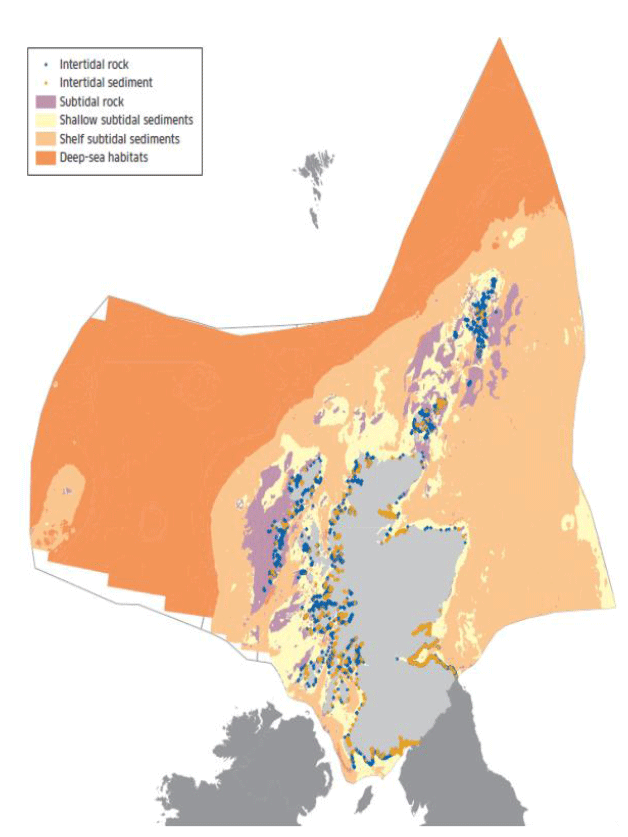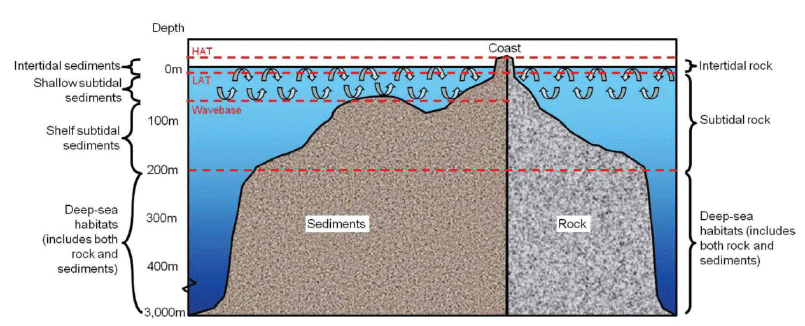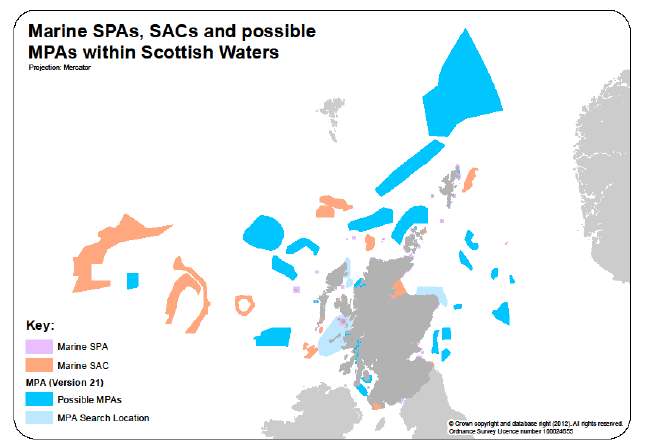National Marine Plan: Sustainability Appraisal Report
This report summarises the findings from a Sustainability Appraisal (SA) of the draft National Marine Plan (NMP). SA of the draft plan is required by the Marine and Coastal Access Act 2009. The SA has considered the potential social, economic and enviro
3.0 Baseline Information and Context
3.0.1 Scotland's location at the edge of the continental shelf means that it is subject to both subpolar and subtropical influences. The North Atlantic current brings warm water from the Gulf of Mexico to the west coast of Scotland. These warm waters mix with cooler polar waters that are rich in nutrients.
3.0.2 Scotland's coastline is over 18,000 km long, and very varied in nature. There are over 900 islands, including the major archipelagos of Shetland, Orkney and the Outer Hebrides. [9]
3.1 Biodiversity, flora and fauna
3.1.1 Scotland's marine environment supports a diverse complex of different habitats, which in their turn support a wide range of marine plants and animals. This diversity owes much to the factors described in paragraphs 3.0.1 and 3.0.2. Current estimates suggest there are around 6,500 species of animals and plants (excluding microbial flora and seabirds) in Scotland's seas (Scotland's Marine Atlas, 2011).
Key Marine Habitats
3.1.2 The seabed is a critical component of marine ecosystems. Six broad habitat types occur in Scottish waters ( Figure 5): intertidal rock, intertidal sediment, subtidal rock, shallow subtidal sediments, shelf subtidal sediments and deep-sea habitats. Figure 6 illustrates the locations of these habitats relative to the shoreline. Overall, mud, sand and coarse sediment are found in the North Sea, to the west of the Hebrides and in the north of Scotland. The seabed in the far west and north of Scotland is characterised by mud and fine clay, with coarser sediments in shallower water and on banks and seamounts [10] . Details of these habitats are provided in the following paragraphs [11] .
3.1.3 Intertidal rock comprises approximately 48% of the Scottish coastline. Large stretches of the west coast and Northern Isles are predominantly rocky, as are the Solway Firth and the Firth of Forth, whereas on the east coast intertidal rock is much more patchy and interspersed by large stretches of sandy and muddy coastline. This habitat, which includes bedrock, boulders and cobbles, is affected by a number of physical factors ( e.g. wave exposure, salinity, temperature and tides).
3.1.4 The various animals and plants found on rocky shores are adapted to survive the stresses imposed by regular immersion and emersion in sea water and the associated fluctuations in temperature and salinity caused by exposure to the sun and rain at low tide. The upper regions of many rocky shores are relatively species-poor, particularly on exposed coasts, but areas nearer to the bottom of the shore can be very species-rich. Rocky shores are popular resting and foraging places for many animals ( e.g. harbour and grey seals, otter and various wading birds).
3.1.5 Intertidal sediments comprise around 50% of the Scottish coastline and include mobile shingle and gravel, sand and mud or combinations of these (including sandflats and mudflats), and saltmarsh in the upper shores. Intertidal sediments predominate on the west coast and in estuaries such as the Solway, Dornoch and Cromarty Firths and the Firths of Forth and Tay.
3.1.6 Intertidal habitats support communities that are tolerant of exposure to air and variable temperatures and salinities, particularly the mudflats and sandflats found in estuaries. The more mobile sediments, e.g. relatively coarse-grained sand, support fewer species of animals, whereas less mobile sediments (such as muddy sands) are more species-rich, supporting communities of amphipods, polychaetes and bivalve molluscs. Mudflats, which are found in the most sheltered areas, are finer (silt and clay) and have a high organic content. Intertidal sediments support such features as seagrass beds, blue mussel beds, and native oysters. Mudflats in particular provide habitat for many juvenile fish and for wintering waders and wildfowl.
3.1.7 Subtidal rock is extensive on the west coast and around Shetland, but is only present in isolated pockets on the east coast. Subtidal rock habitats consist of bedrock, boulders and cobbles occurring below low water mark and the communities found in these areas are affected by the availability of light. Shallow areas are typically dominated by seaweeds; communities in deeper areas comprise exclusively marine animals. Subtidal rock supports such features as Northern sea fan and sponge communities; white cluster anemone; pink sea fingers; European spiny lobster; tide-swept algal communities; and biogenic reefs.
3.1.8 Inshore subtidal and shelf sediments cover an extensive area of the seabed, all around the Scottish coast. Inshore subtidal sediments include shingle, gravel, sand and mud extending to the depth at which there is no effect from waves, typically around 50-70m. The shelf sediments extend to around 200m depth.
3.1.9 Inshore subtidal and shelf sediments support such features as burrowing sea anemone; northern feather star; fan mussel; heart cockle; ocean qhahog; burrowed mud; maerl beds; maerl or coarse shell gravel with burrowing sea cucumbers; inshore deep mud with burrowing heart urchins; shallow tide-swept coarse sands with burrowing bivalves; seagrass beds; and low or variable salinity habitats.
3.1.10 Deep sea habitats are those occurring beyond the continental shelf break at depths typically greater than around 200m. Knowledge of these habitats is limited but is increasing. They are found almost entirely to the north and west of Scotland, and comprise cold water coral reefs, coral carbonate mounds, submarine canyons, sea mounts and deep sea sediments. [12] They support such features as seamount communities; carbonate mound communities; coral gardens; deep sea sponge aggregations; offshore deep sea muds; and cold-water coral reefs.
Figure 5. Modelled distribution of broad habitats in Scotland's marine environment [13]
Figure 6. A generic cross-section of the seabed from the coast to deep waters offshore [14]
Mobile Species
3.1.11 Scotland's marine environment also supports a wide range of mobile species. These include:
- seals (grey and common or harbour)
- cetaceans. Twenty-three species have been recorded in Scottish waters over the last 25 years. Of these, 11 are regularly sighted.
- birds, both breeding seabirds and overwintering waterbirds
- marine turtles
- sharks and rays, including basking shark and common skate
- commercial fish and shellfish
Protected Habitats and Species
3.1.12 The importance of Scotland's marine ecosystems is reflected in the range of designations which protect them at the international, UK and Scottish levels. The range of habitats protected includes estuaries; lagoons; large shallow inlets and bays, mudflats and sandflats; reefs; sandbanks; submarine structures; and sea caves. A wide range of species is protected, including breeding seabirds, overwintering waterbirds, fish and seals, amongst others.
3.1.13 In 2012, there were:
- 85 Special Protection Areas ( SPAs) with marine associations, affording protection to bird species dependent on the marine environment. Thirty-one of the existing seabird breeding colony SPAs have been extended into the marine environment to include the adjacent waters.
- 40 Special Areas of Conservation ( SAC), six candidate SACs, and one possible SAC.
- 188 Sites of Special Scientific Interest ( SSSI) with marine associations / components, of which 61 overlap with the intertidal environment. The remainder have been designated for bird interests associated with the marine environment. An example of the habitats and species protected at the national level (through SSSI designation) is provided in Table 2.
3.1.14 The Marine (Scotland) Act 2010 and the Marine and Coastal Access Act 2009 both contain powers to designate Marine Protected Areas ( MPAs). These contribute to a range of measures to manage and protect Scotland's seas for current and future generations. The legislation also requires that a network of MPAs in UK seas is created to protect biodiversity and geodiversity. The network will contribute to agreements with international partners to create an ecologically coherent network of well-managed MPAs in the north-east Atlantic. The key overall objective of the nature conservation MPA network is to safeguard the most important natural features in Scottish waters, based on the principle of sustainable use [15] .
3.1.15 Possible nature conservation MPAs have been identified, and four further MPA search locations remain to be fully assessed (Figure 7). The evolving MPA network in Scotland's seas builds on the existing network of protected areas (Figure 7), which includes Special Areas of Conservation ( SACs); Special Protection Areas ( SPAs); Sites of Special Scientific Interest ( SSSIs), and fisheries management areas. More information on these other designations and sites is provided in Marine Scotland's report to the Scottish Parliament 19.
Table 2. Marine notified habitats and species features of SSSIs
| Habitats |
Species |
|---|---|
| Eel grass bed |
Brackish water cockle ( Cerastoderma lamarki) |
| Mudflats |
Egg wrack ( Ascophyllum nodosum ecad mackaii) |
| Rocky shore |
Common seal ( Phoca vitulina) |
| Saline lagoon |
Grey seal ( Halichoerus grypus) |
| Sandflats |
Stonewort ( Lamprothamnium papulosum) |
| Sea caves |
Vascular plant assemblage [covers eel grass communities in some sites] |
| Tidal rapids |
Priority Marine Features
3.1.16 SNH and JNCC have developed a list of Priority Marine Features ( PMFs), to provide a new focus for marine conservation activities across the three pillar approach set out in the Marine Nature Conservation Strategy. Some of these PMFs are UK Biodiversity Action Plan species and habitats. UK BAP priority species are those that are identified as being threatened and requiring conservation. There are 74 UK BAP priority marine species listed as priorities in Scotland. These include sea-fan anemone, fan mussel, native oyster and fireworks anemone. These species can be vulnerable to fishing activities. For example, the fireworks anemone is highly sensitive to mechanical damage from mobile fishing gear, particularly trawling for Nephrops and, to a lesser degree, damage from creels.
Figure 7. Marine SPAs, SACs and possible MPAs within Scottish Waters
3.1.17 SNH and JNCC have made recommendations to Scottish Ministers on PMFs, which comprises a list of PMFs for inshore and offshore waters [16] . This includes such marine species as cod, herring, mackerel and ling. The Marine Atlas identifies key PMFs and the pressures affecting them [17] .
Trends and Pressures
3.1.18 The Marine Atlas reviewed the condition of the five major habitat types described in paragraphs 3.1.2- 10. There were few or no concerns about subtidal rock. Intertidal rock and sediments show evidence of deterioration, with one concern being the introduction of such non-native invasive species as wire weed. The most significant level of concern was regarding the condition of shallow and shelf subtidal sediments, mainly as a result of fishing practices such as demersal fishing (trawling) and scallop dredging. There were also some concerns about the effects of trawling on deep sea habitat.
3.1.19 An assessment of the condition of the following species was also made: plankton, cetaceans, grey seals, harbour seals, seabirds, demersal fish, sharks/rays and water birds. Of these, the most concern was expressed about sharks/rays and harbour seals. Populations of sharks/rays are declining and, as these animals are slow growing, late to reach maturity, and typically have low fecundity, populations take some time to recover from such pressures as overfishing. Harbour seal numbers have declined (by over 50%) since 2001 in Shetland, Orkney and the east coast of Scotland, although numbers have remained relatively stable on the west coast and the Inner Hebrides.
3.1.20 Seabird populations are increasing in some areas (Solway Firth and the Clyde, for example) and decreasing in others. In East and West Shetland and along the North Scotland coast, this decrease is most probably related to a shortage of prey species resulting from changes in oceanographic conditions. Like seabirds, waterbirds (wildfowl and waders) are also both increasing and decreasing, depending on the species. The reasons for declines remain to be fully explained but may be due to redistribution of wintering birds across north-west Europe due to climate change effects.
3.1.21 Entanglement of baleen whales in static fishing gear has been observed in Scottish waters, for example, minke whales entangled in creel lines and other ropes. At the time of reporting (2010), such incidents were not considered to be a conservation threat in Scotland [18] .
3.1.22 The Marine Atlas also noted that populations of many commercial fish species are declining, and that this is of particular concern in the Solway Firth, North Channel, Clyde, Minches and Malin Sea, North Scotland coast and West Shetland. Several commercial fish stocks were being fished above the levels consistent with achieving maximum sustainable yield in 2011, including northeast Atlantic mackerel, herring (west of Scotland), cod (North Sea and west of Scotland stocks), blue whiting, saithe and monkfish. Other stocks are fished at sustainable levels, including herring (North Sea), haddock (North Sea, west of Scotland, and Rockall) and Nephrops.
3.1.23 Box 1 sets out current and future pressures on marine biodiversity, flora and fauna.
Box 1. Pressures on marine biodiversity, fauna and flora
| Commercial fishing:
Non-native invasive species may outcompete native species, thereby displacing them from the marine environment. Marine litter can result in the injury and/or death of marine animals, through entanglement, ingestion of litter (including plastic microparticles in particular) or both Dredging:
Marine transport:
Aquaculture:
Marine wildlife watching may result in increased disturbance to populations of marine animals such as whales and dolphins. Recreation:
Offshore renewables, in future:
Climate change, through increasing sea temperatures, acidification, changes to rainfall patterns, etc:
|
3.2 Communities, Population and Human Health
Population distribution and change
3.2.1 The population of Scotland in 2011 was estimated at 5.295 million people [19] . Coastal communities (within 5 km of the coast) make up around 41% of the total population of Scotland, with 68% of the coastal population living within the 'developed coast' consisting of urban areas such as large towns and cities, and 14% living within the 'undeveloped coast' consisting of small towns and rural holds with agricultural land [20] . The 'isolated coast' is remote and sparsely populated but contains 18% of Scotland's coastal population [21] . While there are many settlements on the coast, less than 15% of its length has been developed [22] .
3.2.2 A positive sense of place is important to people living in many rural and coastal areas, and the importance of the quality of the environment raises concerns that detrimental effects on amenity could lead to decreasing populations and adversely impact on property values and businesses.
Employment and Deprivation
3.2.3 Coastal communities play an important role in Scotland's economy, and many areas are economically successful.
3.2.4 Employment information indicates that around 1.6% of Scottish employment was in the core marine sector in 2008 and, of this, some 31% of employment was in the fishing, fish farming or fish processing sectors [23] . The industries that contribute to the core marine sector include:
- construction of water projects;
- renting of water transport equipment;
- fish farms;
- fishing;
- processing and preserving of fish and fish products;
- sea and coastal water transport and supporting activities;
- building and repairing of ships and boats;
- service activities incidental to oil and gas extraction excluding surveying; and
- extraction of crude petroleum and natural gas.
Detailed information on the extent and value of activities in and use of the marine environment is provided in Scotland's Marine Atlas (2011) and in the draft NMP.
Figure 8. Scottish Index of Multiple Deprivation 2012: Overall Rank
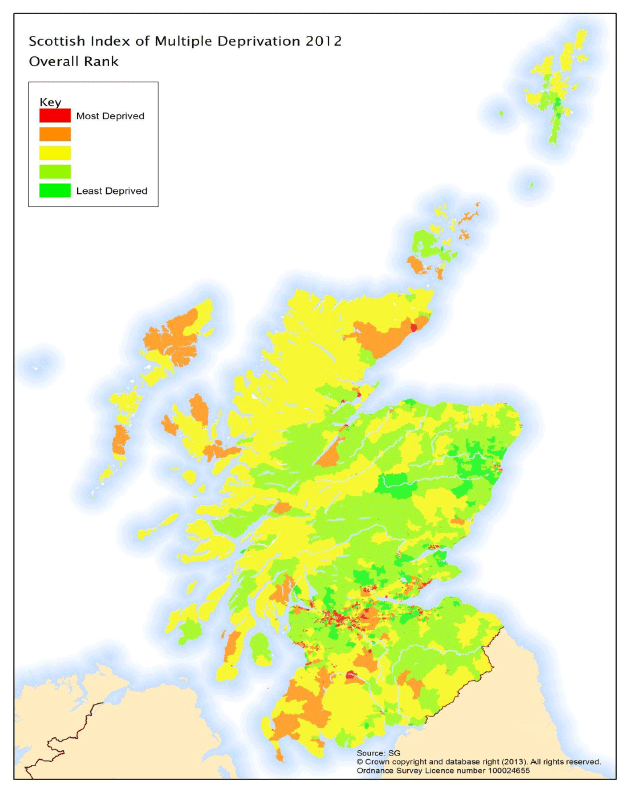
3.2.5 The Scottish Index of Multiple Deprivation ( SIMD) ranks small areas (datazones) [24] from the most deprived to the least deprived. It analyses data for a number of indicators across the domains of income, employment, health, education, skills and training, housing, geographic access and crime. Key findings from the SIMD 2012 [25] show that multiple deprivation in Scotland has become less concentrated over time. In SIMD 2004, nearly half of all datazones in the most deprived 10% across Scotland were in Glasgow City. In SIMD 2012 this dropped to 35.8%, with increases in other areas. The most deprived datazones include parts of Renfrewshire and Glasgow City. North Lanarkshire, Fife, Renfrewshire and East Ayrshire have seen relatively large increases in their share of datazones in the 15% most deprived areas in Scotland between SIMD 2009 and SIMD 2012. Glasgow City, Edinburgh City, West Lothian, Aberdeen City and South Lanarkshire have seen relatively large decreases in their share of datazones in the 15% most deprived areas in Scotland between SIMD 2009 and SIMD 2012.
3.2.6 Neighbourhood statistics data for local authorities with a coastline and the Scottish Index of Multiple Deprivation ( SIMD) show that the majority of coastal communities are not included within the lowest percentiles, and appear to suffer less income and employment deprivation than the inner city and urban areas in Scotland's central belt [26] . The exceptions are clusters of urban communities in the south-west around Ayr and Irvine, in the north-east around Aberdeen, in Eilean Siar and in some parts of south-west Dumfriesshire. The mapping of the Scottish Index of Multiple Deprivation (Figure 8) shows the spatial concentration of disadvantage in urban areas of Scotland, particularly west central Scotland, but also in other areas.
3.2.7 There is an east-west split in the rural characteristics of coastal communities, with the islands, north and west coasts typically having smaller populations and experiencing greater distances to services. Communities on the west coast and islands typically have a greater reliance on marine businesses and related industries as part of their local economy. Communities in the east and north, including Shetland, are active in the oil and gas sectors. Further details are provided in the following paragraphs.
3.2.8 There are challenges for some coastal and island communities. This includes some of the more remote areas such as Eilean Siar, parts of Caithness and Sutherland and Kintyre, where there has been a continuing decline. Through the Fragile Areas Programme, Highlands and Islands Enterprise ( HIE) and local authorities are giving particular attention to the needs of the Outer Hebrides, north Skye, the outlying islands of Orkney and Shetland, the Argyll islands and the remote west mainland. The locations of more fragile areas in these parts of Scotland are shown in Figure 9.
Figure 9. Highlands and Islands Enterprise Fragile Areas [27]
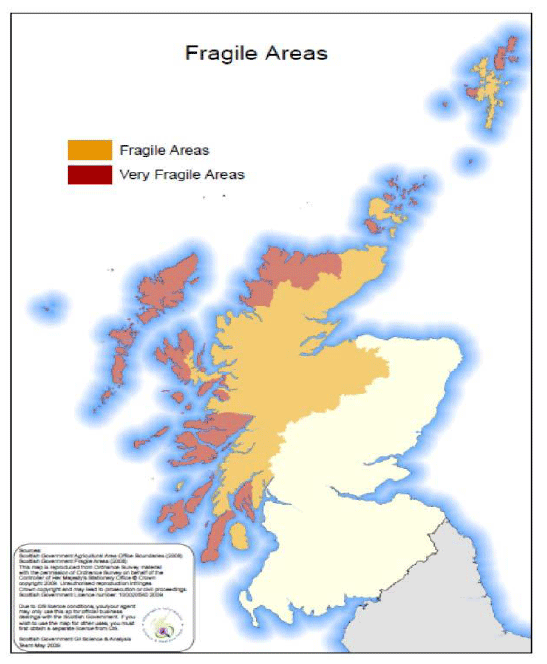
North East
3.2.9 Scottish coastal communities play an important economic role in the north-east. Aberdeen Harbour, for example, is important in providing support to the offshore industry and in accommodating a growing volume of freight.
3.2.10 Peterhead is the North Sea's largest white fish port, and also provides logistical support for the North Sea oil and gas industry whilst handling an increasing number of cruise vessels. The port of Montrose provides import and export services for agricultural and oil related businesses and is a base for oil rig support vessels.
North
3.2.11 The Moray Firth area has experienced substantial growth, while Orkney and Shetland have benefitted from oil and gas related activities.
North West
3.2.12 The expansion of salmon and shellfish farming, tourism, food processing, small-scale manufacturing and service provision has contributed to growth in areas such as Skye, Mull, Arran, Wester Ross, Ardnamurchan and mid Argyll, underlining the importance of their coastal location and character.
West and South West
3.2.13 Ayrshire and the south-west are an important gateway for Scotland, with extensive coastal areas of a rural character. Coastal towns such as Ayr, Troon and Hunterston play an important role as key transport corridors in the region.
Marine Transport and Connectivity
3.2.14 Connectivity is one of the key challenges facing rural and island communities. Figure 10 shows that coastal communities are within the lowest percentiles when assessed in terms of the index focusing on access to services.
3.2.15 The Scottish Government continues to pilot the Road Equivalent Tariff ( RET) for some ferry services and is seeking to improve access and connectivity by promoting improved integration between public transport and existing ferry routes. The Scottish Government also subsidises flights to the Highlands and Islands for residents, reflecting the importance of these lifeline services to communities.
3.2.16 Ferries are a key component in maintaining connectivity to and between Scotland's more fragile and remote communities, including the islands. Many ferry routes are subsidised by Scottish Government or local authorities to maintain or improve the economic and social conditions of the Highlands and Islands. This includes support to business and tourism, delivery of goods and access to schools and healthcare.
Figure 10. Areas in Scotland ranked according to Access Domain (Source: Scottish Index of Multiple Deprivation)
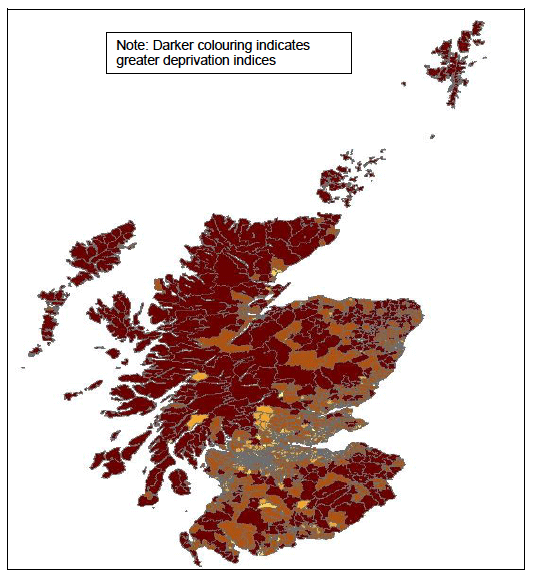
3.2.17 In total Scottish ferries carried some 7.9 million passengers in 2011 [28] . Of these:
- CalMac ferries carried about 5 million passengers;
- Northlink ferry services carried 304,000 passengers to and from Orkney and Shetland;
- Orkney Ferries intra-island services carried 337,800 passengers; and
- 615,000 passenger journeys were made on Shetland Islands Council services.
There were 1.9 million passenger journeys between Scotland and Northern Ireland in 2010.
3.2.18 There are four international airports in Scotland with scheduled services: Edinburgh Airport, Glasgow International Airport, Aberdeen Airport and Glasgow Prestwick International Airport. Highlands and Islands Airports Limited operate eleven small airports across the Highlands, Orkney, Shetland and the Western Isles (Sumburgh, Kirkwall, Wick, Stornoway, Inverness, Benbecula, Barra, Tiree, Islay, Dundee, and Campbeltown) [29] .
Health, wellbeing and deprivation in coastal areas
3.2.19 Health SIMD [30] data (Figure 11) demonstrates that coastal and island communities are mostly ranked within the top 20-100% of all areas in Scotland, although there are parts of the north and the Western Isles where health conditions appear to be in or moving towards the lower percentiles.
3.2.20 Research has identified that coastal zones are less likely to be deprived than inland areas [31] with just 6% of these areas in the East Region falling into the most deprived percentile (compared with 12% of all data zones), 0% in South West (compared with 3% of all data zones) and 11% in West Region (compared with 15% of all data zones). The North East had just 2% (compared with 15% of all data zones), the West Region just 1% (compared with 9% of all data zones), and the South West 0% (compared with 1% in all data zones).
3.2.21 Between 2006 and 2011, the mental well-being of adults in Scotland averaged a score of 50 [32] (the score can range between 14 and 70, with a higher score indicating better well-being).
3.2.22 Access to the outdoors can provide opportunities for exercise with benefits for physical and mental health and well-being, including reducing obesity and combating stress. The number of adults who made at least one recreational visit to the outdoors was around 78% between 2005 and 2008, with the most commonly visited areas being parks and open spaces (37% of visits). Whilst some 50% of people overall have local greenspace within five minutes of their home, this figure is 39% in deprived areas. [33] Greenspace provides a key opportunity for direct contact with the natural environment, particularly in urban areas, and this has measurable physical and psychological benefits.
3.2.23 Findings from the Scottish Health Survey 2010 for the adult population found that 44% of the population had participated in sporting activities in the previous four weeks. This decreased with age, from 68% of those aged 16-24 down to 13% of those aged 75 and over. Common activities for adults include working out at the gym, doing exercises, swimming and running/jogging. [34]
Figure 11. Areas in Scotland ranked according to Health Domain
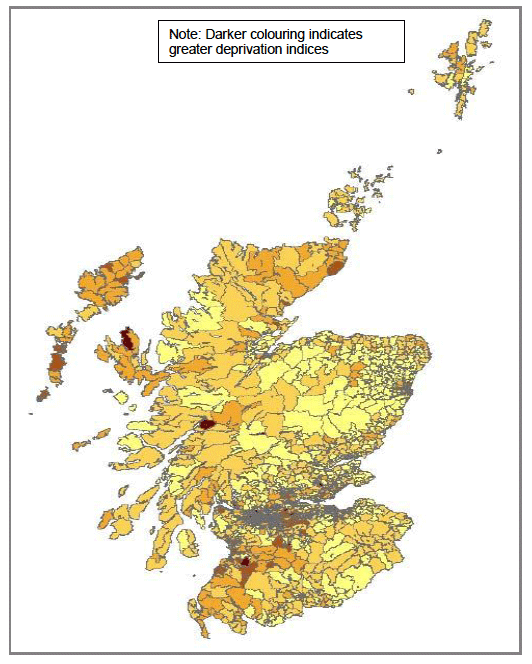
3.3 Water Quality and Ecological Status
3.3.1 Scottish waters are quite different between the east and west coasts. The east coast presents mostly uniform depths and shallow inclines interspersed with localised trenches, while the seabed off Scotland's west coast shelves steeply away from the coast, and deep waters occur relatively close to the land.
3.3.2 There are various mechanisms in place for monitoring and managing the quality of Scottish waters. Each takes a different focus and approach:
- The Water Framework Directive establishes a framework for the protection of inland surface waters (rivers and lakes), transitional waters (estuaries), coastal waters and groundwater, with the aim of ensuring that all aquatic ecosystems meet 'good status' by 2015. [35],[36]
- River Basin Management Plans [37] have been prepared for the Scotland and Solway-Tweed River Basin Districts to address the requirements of the Water Framework Directive in relation to the management of Scotland's river systems. Both plans also provide an overview of the state of the water environment for their districts.
- Scotland's coastal waters are monitored by SEPA to measure performance and compliance with targets for coastal water quality status under the Water Framework Directive.
3.3.3 Scotland's seas are mostly classed as being of good or better ecological status under the Water Framework Directive (out to 3 nautical miles). There are some poorer quality waters in certain areas, such as the Firth of Forth and the Firth of Clyde. The key risks to the quality of the water environment are from contamination as a result of marine activities, such as the use of anti-fouling paint, pollution from oil and/or chemical spills, and pollution of coastal waters from activities on land, in particular from agricultural activities.
3.3.4 In 2011, the ecological status [38] of 61% of Scotland's surface water bodies was good or better (Figure 12) [39] . The following were in good or better condition:
- 96% of coastal waters;
- 86% of estuaries;
- 54% of rivers; and
- 63% of lochs.
Figure 12. Coastal and Transitional Waters Classification 2011 (Source: Scotland's Environment website) [40]
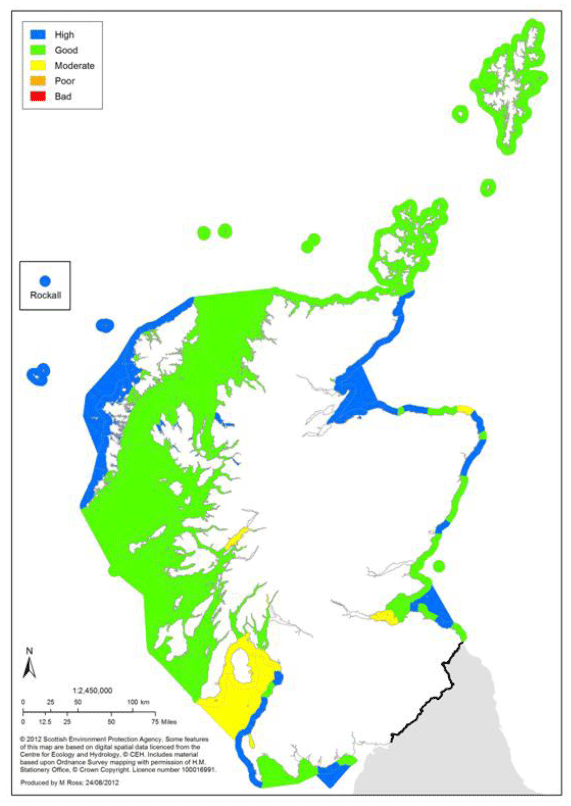
Bathing waters
3.3.5 In 2012, 98% of Scotland's 83 bathing waters achieved the mandatory standard for bathing water quality and almost two-fifths also met the more stringent guideline standard. In summary, of the 83 identified bathing waters:
- 32 (39%) were classified as being of guideline quality for EU compliance;
- 49 (59%) were classified as being of mandatory quality for EU compliance; and
- 2 (2%) were classified as being of failing quality for EU compliance [41] .
Flooding
3.3.6 Flooding has affected many of Scotland's coastal communities, through river flood events, coastal flooding resulting from high tides and storm conditions, and surface water flooding following heavy rainfall events. The SEPA National Flood Risk Assessment provides an overview of flood risk in Scotland. It identifies that coastal flooding accounts for around 17% of all predicted flooding impacts in Scotland.
3.3.7 A review in 2008 of 340 historic coastal flood records spanning a 160-year period identified flooding around much of the Scottish coastline, with the highest number of reported events from the Solway Firth, the Moray Firth, Aberdeenshire and the Firth of Clyde. Flooding in the north-west of Scotland was less frequent than in other parts of the country. However, the Sniffer report on Coastal Flooding in Scotland also identified that storms driven in from the Atlantic Ocean during periods of strong westerly winds are associated with a higher incidence of coastal floods in Scotland [42] .
3.3.8 Low-lying communities located along estuaries and coastlines are considered to be particularly vulnerable to coastal flooding, and around 27,000 residential and commercial properties in Scotland are considered to be at risk of inundation by a 1 in 200 year coastal flood. The areas considered to be most at risk of coastal flooding include Scotland's populated firths ( i.e. Firth of Forth, Firth of Tay, Firth of Clyde and the Inner Clyde Firth), sections of Scotland's east coast, and parts of the Northern and Western Isles [43] (Figure 13). With rises in sea level, and increases in storm surges and waves predicted with further climate change [44] , the frequency and severity of flooding in Scotland's coastal areas is anticipated to increase, and likewise, the number of properties at risk. [45]
Figure 13. National Flood Risk Assessment Map [46]
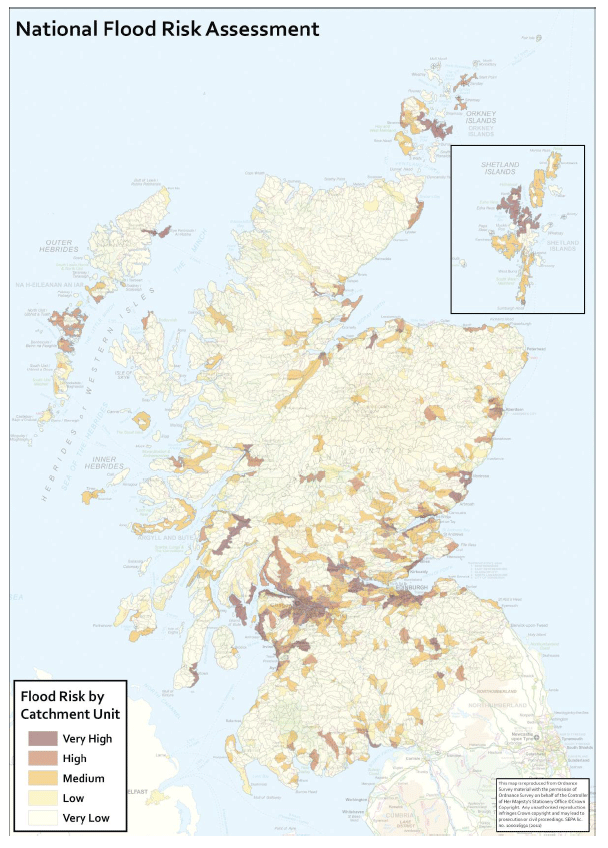
Spills
3.3.9 A key issue pressure on water quality is accidental spills, e.g. oil. Reporting by the Advisory Committee on Protection of the Sea ( ACOPS) [47] has identified spills from vessels and from oil and gas installations for the years 2002-11. Vessels include fishing vessels, offshore supply/support vessels, oil tankers, general cargo vessels, pleasure craft, roll-on roll-off ferries, military vessels, dredgers and unidentified vessels. The average number of spills per year is 50. The majority of spills (44%) come from fishing vessels (Figure 14), with the volume of most spills being between 0-99 litres. All were the result of incidents ( e.g. bunkering spills) or accidents ( e.g. running aground, sinking). Spills were either treated by clean-up operations or tended to disperse naturally.
3.3.10 ACOPS also reported discharges from oil and gas installations and vessels operating in UK waters. For example, in 2011:
- A total of 279 accidental oil discharges were attributed to oil and gas installations including those operating in the west Shetland Basin. (The data does not facilitate disaggregation between Scottish offshore waters and UK offshore waters.)
- There were 240 notified accidental discharges of chemical substances. Over 80% were considered under the OSPAR list of substances used and discharged offshore as Posing Little or No Risk to the Environment ( PLONOR). None of the chemicals spilled are included in the OSPAR list of chemicals for priority action, which are considered to pose the greatest hazard. None of the spill incidents resulted in a significant environmental impact.
- There were 24 incidents involving surface sheens or thicker oil slicks reported by the nearest offshore installation but attributed to a discharge from a 'third party' elsewhere that was generally assumed to have been a passing vessel.
- Four offshore supply/support vessels had accidental discharges of oil to Aberdeen Harbour in 2011.
Figure 14. Overall spills from vessels between 2002-2011 (Source: ACOPS)
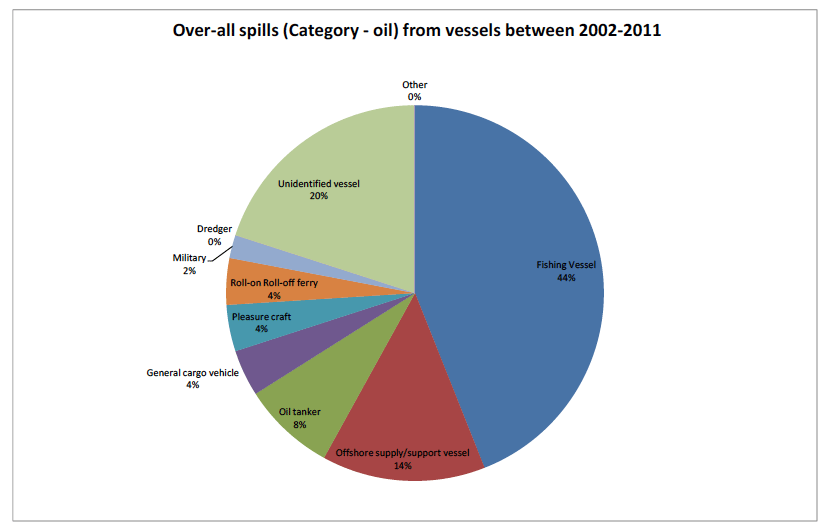
3.4 Air quality
3.4.1 The National Atmospheric Emissions Inventory maps [48] for NOx, PM 10 and SOx show elevated levels along key shipping routes, including the IMO routes through the Minches and along the Atlantic coast of the Western Isles (Figures 15, 16 and 17), and routes in the Firths of Forth and Clyde. Similar elevated levels can be seen in the Firth of Lorn, on routes to Orkney and Shetland, and on routes departing from/arriving at Aberdeen.
3.4.2 Atmospheric emissions from shipping are controlled at international, European and UK levels. Annex VI of the MARPOL Convention [49] limits the level of NO x and SO x from engine emissions:
- NOx emissions are limited to between 17.0g/kWh and 7.7g/KWh depending on vessel age and engine rated speed. This is scheduled to be reduced further following a technical review in 2013.
- The North Sea is designated as an IMO Emission Control Area ( ECA) for SOx. From 1 January 2012 SOx limits have been set at 3.50% m/m outside the ECA. Emissions of SOx are limited to 1.00% m/m within the ECA, and are set to fall to 0.10% m/m from January 2015.
The Sulphur Content of Liquid Fuels Directive [50] (as amended by Directive 2005/33/EC) limits the sulphur content of fuel used by vessels to 1.5%.
3.4.3 The domestic ferry and Scottish fishing fleets predominantly run on marine gas oil. Ferries on a few routes ( e.g. to Orkney and Shetland) run on intermediate fuel oil.
3.4.4 Air pollution can have repercussions for many aspects of quality of life, including human health. Long-term exposure to poor air quality is associated with a number of health complaints, including an increased risk of cardiopulmonary disease [51] . Emissions from marine vessels have the potential to be felt in ports and the communities in their environs, for example, due to the running of engines to provide onboard power whilst vessels are in port.
3.4.5 Thirty-two Air Quality Management Areas ( AQMAs) are designated in Scotland. [52] They are predominantly located inland, in urban areas, and are mainly linked to road-based transport. All are designated as a result of nitrous oxides (NO x) and particulate matter (PM 10)). The exception is the AQMA at Grangemouth, in an area encompassing a petrochemical complex, which is designated for sulphur oxides (SOx). The AQMA in Aberdeen City Centre borders the western boundary of Aberdeen Harbour and is designated for NO x and PM 10.
Figure 15. UK Emissions Map of NOx 2010
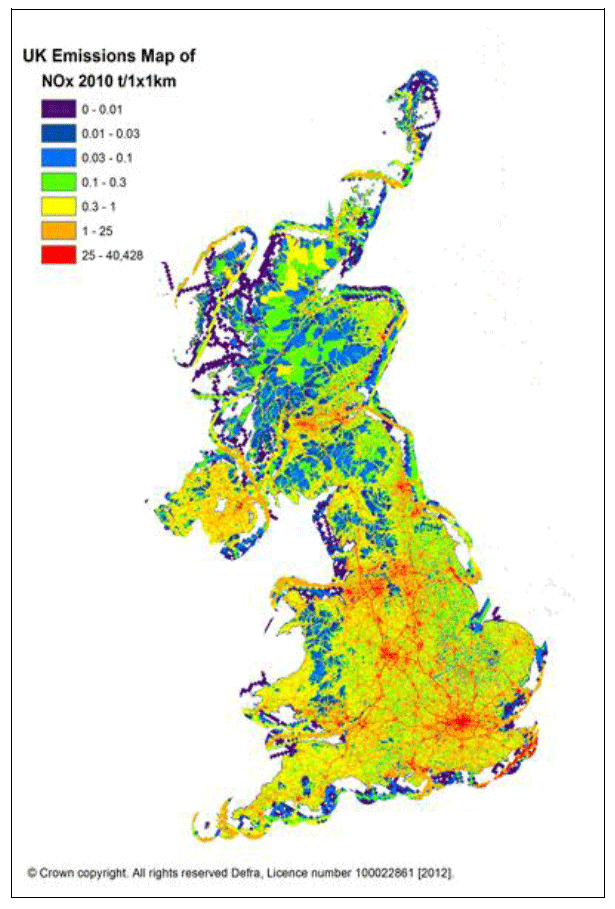
Figure 16. UK Emissions Map of PM 10 2010
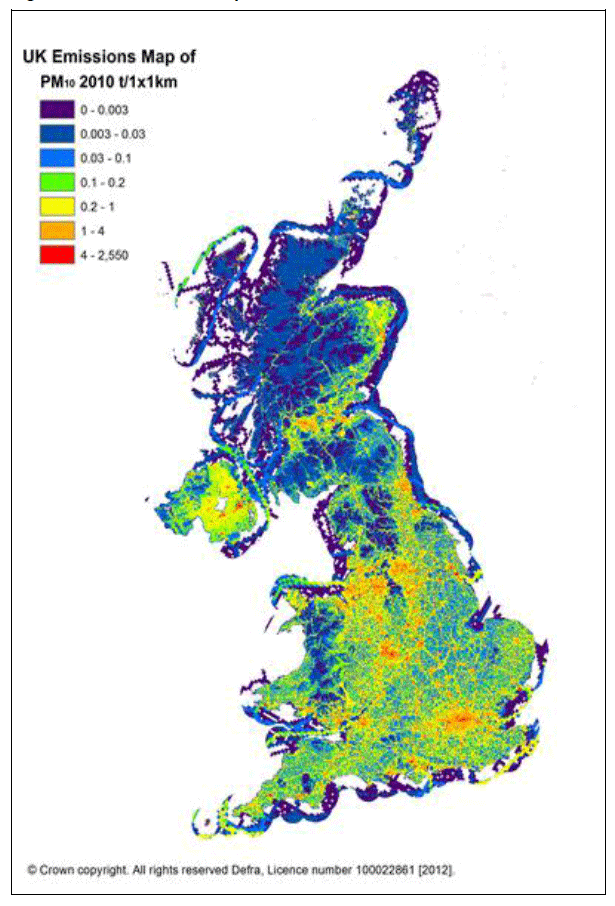
Figure 17. UK Emissions Map of SO 2 2010
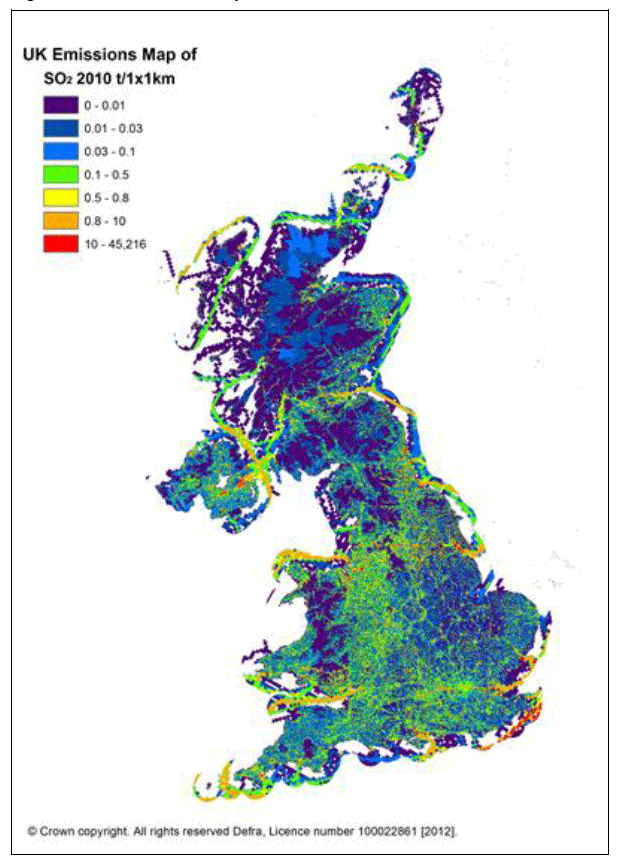
3.4.6 The aim of AQMAs is to ensure that the national air quality objectives will be achieved by the relevant deadlines. The objectives have been set to protect human health and the environment. From the existing data, it would appear that emissions from vessels are not breaching the national air quality objectives.
3.5 Climatic Factors
3.5.1 In the marine context, climate change has been predicted to lead to an increase in water temperatures, rise in sea levels, changes in wave heights and changes to coastlines. Since 1961, average temperatures in all parts of Scotland have risen for every season [53] and over the last three decades, sea-surface temperatures around the UK coast have also risen by approximately 0.7ºC. [54] At the same time, the seas are becoming more acidic, particularly those to the north and west of Scotland, as increasing amounts of atmospheric carbon dioxide are absorbed at the sea surface. This change in acidity is already causing concern for marine ecosystems. [55]
3.5.2 Sea levels around the UK rose by about 1 mm/yr in the 20th century (corrected for land movement), although it is estimated that recent increases have been higher than this. [56] Under projections from the UKCIP09 model [57] , further rises of between 12 and 76 cm are projected by 2095 [58] , with the added potential for further adverse impacts on coastal areas and transitional waters. It should be noted that lower probability scenarios suggest this rise could be even greater.
3.5.3 Changes to sea levels, increased wave height and storm surges could have serious repercussions for the marine and coastal environments, and the many industries operating in them. As noted previously, climate change is already affecting the marine environment, and increasing the vulnerability of some habitats and species to future pressures.
3.5.4. For example, changes in the climate could result in a shift in distribution and changes in the abundance of fisheries through a loss of certain habitats and species, changes in species, changes in species migration and impact on breeding cycles and food supplies. Climate change may also favour some species leading to, for example, increased diversity of seabed marine life due to the warming of the air and seawater temperatures. [59] Risks from pests, diseases and invasive species may increase. There may also be a decline in ocean primary production and effects on increased ocean acidity. [60]
Vessel fuel emissions
3.5.5 Carbon dioxide (CO 2) is the primary greenhouse gas emitted through human activities. The main human activity that emits CO 2 is the combustion of fossil fuels (coal, natural gas and oil). Marine diesel (also known as gas oil or red diesel) is used by the majority of fishing vessels and is also the main fuel used by ferries.
3.5.6 In 2011, greenhouse gas [61] emissions from transport in Scotland amounted to 13 MtCO2e, or 25.3% of total Scottish emissions. The majority (9.3 MtCO 2e) were from road transport. [62]
3.5.7 Overall, transport emissions (including international aviation and shipping) have increased 0.1% since 1990. In 2011, emissions from domestic transport were 0.2% lower than 1990, at 10.47 MtCO 2e, while emissions from international aviation and shipping in 2011 were 2.49 MtCO 2e, up slightly from 2.45 MtCO 2e in 1990 (aviation emissions rose significantly while shipping emissions fell).
3.6 Cultural Heritage
3.6.1 Given Scotland's geographical position on a nodal sea route linking northern Europe with the world, its seas have historically been of international importance. [63] Scotland's seas and coasts therefore support a wide range of historic and archaeological sites. These are found on the coast, the foreshore and the seabed, ranging from the remains of ships and aircraft lost at sea to harbours, lighthouses and other structures along the coast. These historic assets are a non-renewable resource, and their survival is conditioned by a complex interplay of natural and man-made factors.
3.6.2 Coastal erosion poses a major threat to archaeological sites in many areas, a threat that is likely to be exacerbated given predictions of the likely effects of global warming ( i.e. sea level rise, increased intensity of storms, erosion and risk of flooding). However, human activities such as anchoring, certain types of fishing, and coastal and marine development are also known drivers of change in the marine historic environment.
3.6.3 Many sites lie wholly within the marine environment; however, it is believed that there are many more unprotected sites of interest on and around the coastline. The Orkney and Shetland coasts, in particular, contain many Neolithic and Mesolithic structures that are now below sea level. As such, Scotland's seabeds and inter-tidal areas contain the remains of many important historic assets, ranging from artefacts and structures deposited on the seabed, structures built on the seabed or in inter-tidal areas, and submerged sites that were previously above sea level.
3.6.4 While the survival of prehistoric remains is likely to be mainly focused in the sheltered sea lochs and enclosed bays of the east coast of the Shetlands, Orkney and Fair Isle [64] , and in submerged caves and gullies, the following potential locations for the survival of prehistoric archaeological material on the seabed have also been identified [65] :
- on the shelf to the west of the Hebrides;
- the Hawes Bank and seabed around Coll and Tiree;
- around Islay, Jura, Colonsay and Oronsay;
- the Rum and Canna coastline;
- in sheltered inlets and reaches to the east of the Hebrides;
- in sheltered inlets around Skye;
- on submerged islands located between the Northern Irish coast and the south Hebridean islands;
- in the sea to the east of Orkney and Shetland; and
- off the east coast of the Scottish mainland.
Designated sites
3.6.5 While the number of heritage assets within the marine environment is significant, there are relatively few that have been afforded statutory protection through designation. At present Scotland has 34 statutory designated sites wholly within the marine environment (Figure 18). These include eight designated wreck sites around the coast, nine scheduled monuments (including seven wrecks in Scapa Flow), four listed lighthouses and 13 sites designated under the Protection of Military Remains Act 1986. [66] Several battlefields have also been identified in coastal locations.
3.6.6 Coastal sites include World Heritage Sites (St Kilda and the Heart of Neolithic Orkney), scheduled monuments, gardens and designed landscapes, archaeological remains, listed buildings and other sites located in conservation areas. [67]
3.6.7 The Marine (Scotland) Act 2010 provides for the designation of Historic Marine Protected Areas ( MPAs). The designation process will include a review and transition of existing designated wreck sites and underwater scheduled monuments to historic MPA status and identification of further priority sites, in line with guidelines and criteria drawn up by Marine Scotland. Further guidance on the management of changes within MPA sites is also currently being progressed.
Figure 18. Marine Cultural Heritage Statutory Designations
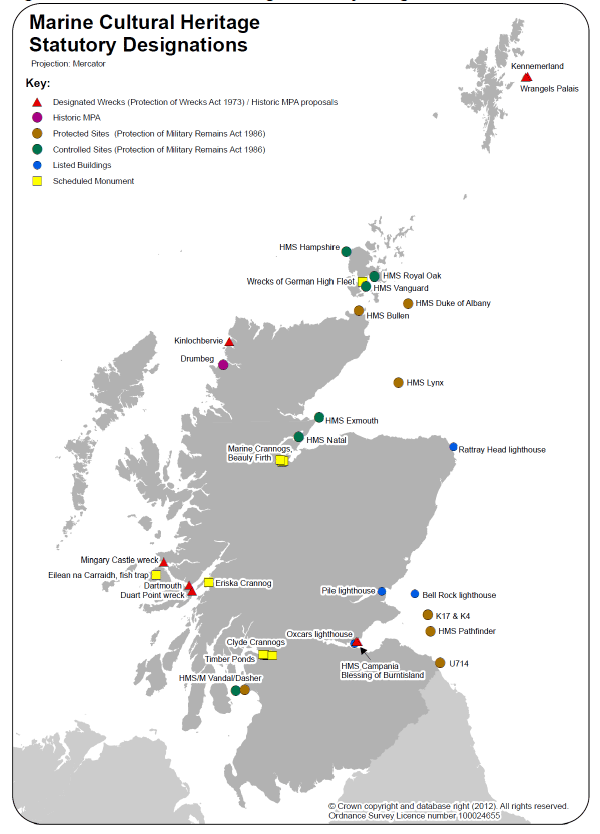
3.7 Landscape/Seascape
3.7.1 Scotland has many high quality landscapes, with many iconic views and scenic areas. Nationally important landscapes are protected as National Scenic Areas. Scotland also has extensive areas of relatively remote and inaccessible wild land, particularly in the north and west.
3.7.2 The European Landscape Convention was ratified by the UK in 2006. Its aims are to promote protection, management and planning of all landscapes. These aims encompass both landscape and seascape, i.e. 'landscape with views of the coast or sea and the adjacent marine environment with cultural, historical and archaeological links with each other'.
3.7.3 The forty National Scenic Areas ( NSAs) in Scotland represent Scotland's finest landscapes and cover 13% of the land area (Figure 19). NSAs are found across all of Scotland, with a significant concentration in the north and west, and are largely focused on upland and coastal landscapes, although they also include lochs, estuaries and river valleys. More than half contain a coastal and/or marine element.
3.7.4 The coast also provides the landscape setting for Scotland's World Heritage Sites at St Kilda and the Heart of Neolithic Orkney. Several sites located in Northern Ireland ( i.e. Giant's Causeway and Causeway Coast World Heritage Site) and England ( i.e. Frontiers of the Roman Empire and Hadrian's Wall World Heritage Site) have also been designated by the responsible authorities in those parts of the UK. World Heritage Status covers both landscape and historic environment attributes, and several of these sites have coastal elements.
3.7.5 A number of local authorities have identified local landscape designations. Many of these local designations lie in coastal locations in the Northern and Western Isles, and along the south-western, western, north-western and northern coastlines of the Scottish mainland.
3.7.6 Scottish Natural Heritage has been progressing work to identify areas of 'wild land.' [68] Areas with stronger wild characteristics are more commonly found in the north and west, particularly areas of higher ground, and some coastal and island areas. This is based on four attributes:
- perceived naturalness of the land cover,
- ruggedness of the terrain,
- remoteness from public roads or ferries, and
- visible lack of buildings, roads, pylons and other modern artefacts.
3.7.7 These are focused on land and do not include waters off the coast or further offshore. Figures 20 and 21 illustrate the core areas of wild land and provide an overview of the high level of wildness attributed to coastal areas on Scotland's north-west coast and in the Western Isles in particular.
3.7.8 Scotland's landscape provides many different benefits. [69] Accessible attractive landscapes support health and well-being by encouraging physical activity, providing many opportunities for enjoyment and recreation. Tourism is vital to the economy: direct expenditure was £4.3 billion from overnight visitors in 2012, and there are 185,900 employees within the tourism sector (2011 figures), approximately 8% of employment in Scotland. The economic benefits of tourism are important for rural areas.
Figure 19. National Scenic Areas in Scotland
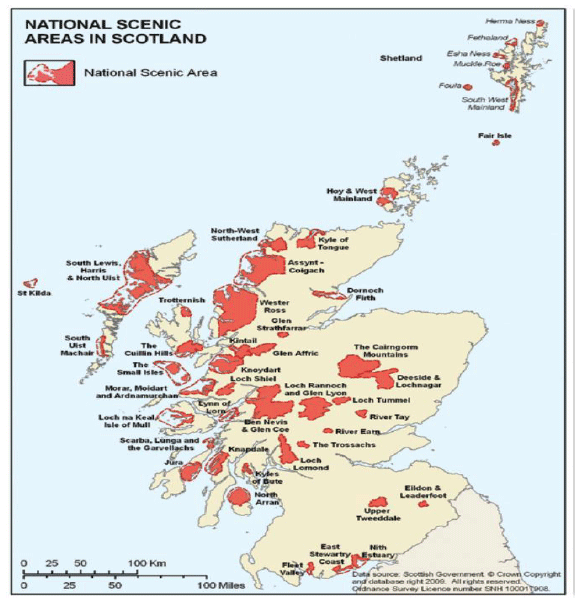
Figure 20. Core Areas of Wild Land in Scotland 2013 [70]
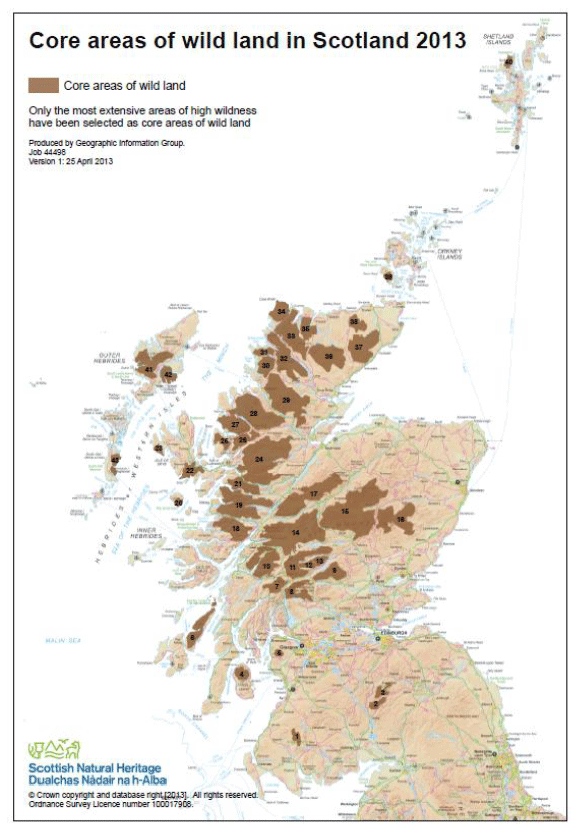
Figure 21. Map of Relative Wildness in Scotland [71]
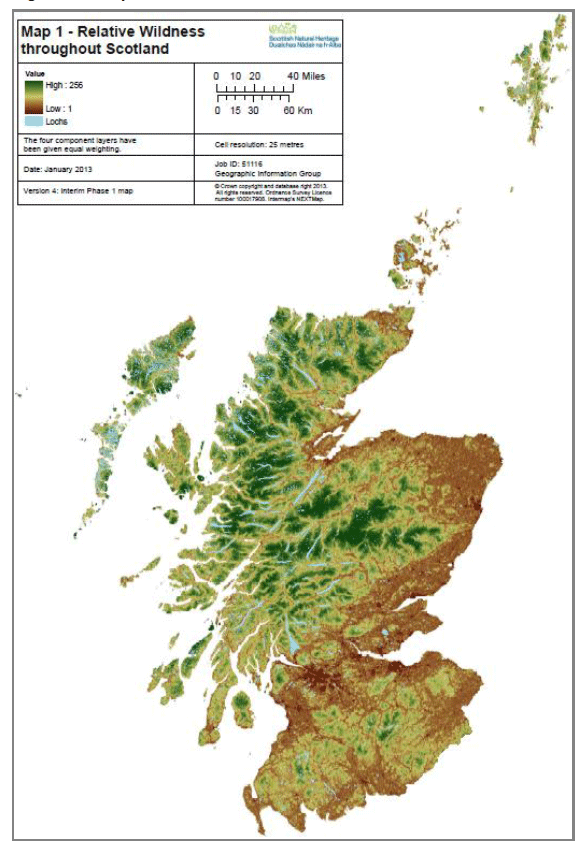
3.8 Sediments and Coastal Processes
Seabed and sediments
3.8.1 The quality of the water environment is closely linked with both the quality of sediments and biodiversity. Marine sediments play a key role in marine ecosystems.
3.8.2 Data from the British Geological Society ( BGS) demonstrates that Scottish waters display a wide range of seabed habitats, ranging from scoured rock or coarse sediment to muddy gravel or fine sand in some areas. In general, these marine sediments are sandy or gravelly and originate from deposits during the Quaternary glaciation. Muddy sediments occur principally nearshore or, further offshore, in depressions on the sea floor, where currents may be relatively weak. They also occur beyond the shelf break (200m water depth) to the west of Scotland. The concentration of calcareous material varies greatly in seabed sediments, reflecting the amount of shell material in different areas; locally, it can be very high. [72]
3.8.3 Much of Scotland's landscape and coastline was initially formed through the processes of glacial erosion and deposition [73] . Today the land continues to change through coastal processes such as wave action, sediment movement, erosion and accretion [74] . The 2004 Eurosion survey of Scotland's coastline reported that it comprises predominantly hard coasts consisting of rocks and cliffs (70%); soft coasts considered potentially susceptible to erosion impacts, consisting of unconsolidated gravels, sand and silts (29%); and artificial coasts such as harbours and sea walls (less than 1%) [75] .
Scotland's Bathymetry
3.8.4 The offshore environment in Scottish waters ranges from shelf sea areas to deep ocean regions with depths greater than 2,000m. The continental shelf includes the Malin and Hebrides Shelf Seas, Orkney and Shetland Shelf Seas, and the North Sea. The shelf seas are marked by notable features such as banks ( e.g. Stanton Banks, Viking Bank) and deep channels.
3.8.5 The bathymetry of Scottish waters shows a sharp distinction between the east and west coasts. The east coast bathymetry presents mostly uniform depths and shallow inclines interspersed with localised trenches. The water deepens to the east towards the North Sea to an average of around 100m, with deeper sections of up to 200m present in some locations ( e.g. the south east Moray Firth, the Devil's Hole and 110 mile Holes). These depths also increase to the north of the Shetland Isles, where the average depth is estimated to be around 110m inshore of the shelf edge.
3.8.6 In contrast, the seabed off Scotland's west coast shelves steeply away from the coast, and deep waters occur relatively close to the land, contrasting the shallow shelving found to the west of the Outer Hebrides. The west coast bathymetry has been deepened by glacial scouring, as demonstrated by sea lochs such as those in the Argyll and Bute area, and depths can be highly variable. Beyond shallow coastal areas, it is estimated that the average depth is around 60m off Scotland's west coast, although a wide range of depths between 10 - 320m have also been identified in some areas.
3.8.7 The shelf edge or western trench creates a natural bathymetric demarcation that borders Scotland to the west. This trench starts at between 40 and 60 miles west of the Outer Hebrides, and follows a broadly north-south direction off the west of Scotland, and a northeast-southwest direction further to the north. Depths generally increase rapidly offshore, roughly ranging from 200m to greater than 2,000m [76] .
Coastal Change
3.8.8 There is a strong interaction between wave, tide and current energy, and the processes of erosion and sedimentation. For example, these processes can aid stability of soft shorelines through the supply of sediment, and can reduce stability through the removal of sediment.
3.8.9 Coastal erosion and accretion are significant problems affecting many coastal communities, both in Scotland and around the world. While natural wave action, tidal currents and drainage have typically been the main drivers of coastal erosion, in more recent times, human activities ( e.g. land reclamation, coastal or offshore, etc.) and natural disasters have also played a significant role in exacerbating these natural processes [77] .
3.8.10 The Marine Climate Change Impacts Partnership ( MCCIP) estimated that in 2010-11, around 7% of Scotland's coast was protected by engineering or artificial structures [78] . The use of engineered sea defences and softer solutions such as the managed realignment of coastlines may become increasingly important in the future with additional pressures from rising sea levels and erosion/deposition associated with climate change [79] . Of the estimated 429km of artificial coastline on Scotland's mainland, some 307km is part of coastal defences, with the remainder being other developments ( i.e. piers and harbours) [80] . However, these sea defences themselves can also have adverse effects on the coast. For example, inappropriate defences can transfer erosion issues further along the coast [81] , and offshore developments have the potential for creating similar effects.
3.8.11 The Eurosion project undertaken in 2004 categorised Scotland's coast and summarised the nature of the coastline, whilst assessing its potential stability and behaviour (Figure 22). This assessment found that three quarters of Scotland's coast was considered broadly stable, and 8% was considered accretional [82] . In 2010-11, it was estimated that 12% of Scotland's coastline was erosional. The sections of Scotland's coastline identified as being subject to either erosion or accretion include key areas along the east coast between Montrose and Dunbar, the Firth of Clyde, the inner Moray Firth, and parts of the Northern and Western Isles (Figure 23). Coastal protection plans have been introduced in some of these areas [83] . The erosional portion of coastlines largely consists of beaches, sand dunes, conglomerates/soft-rock cliffs, machair and marshes with muddy sediments [84] .
Figure 22. Eurosion Coastal Survey and Erosion Potential
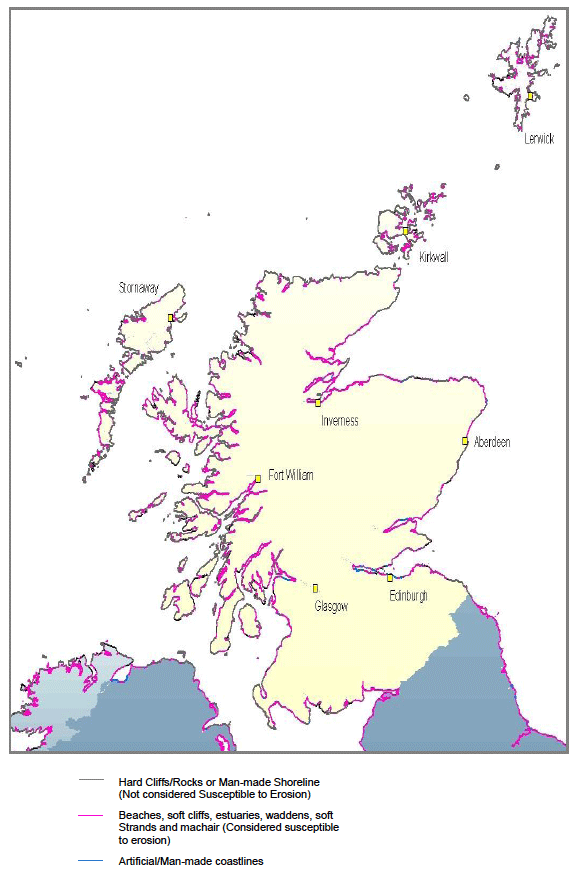
Figure 23. Eurosion Coastal Erosion Survey 2000
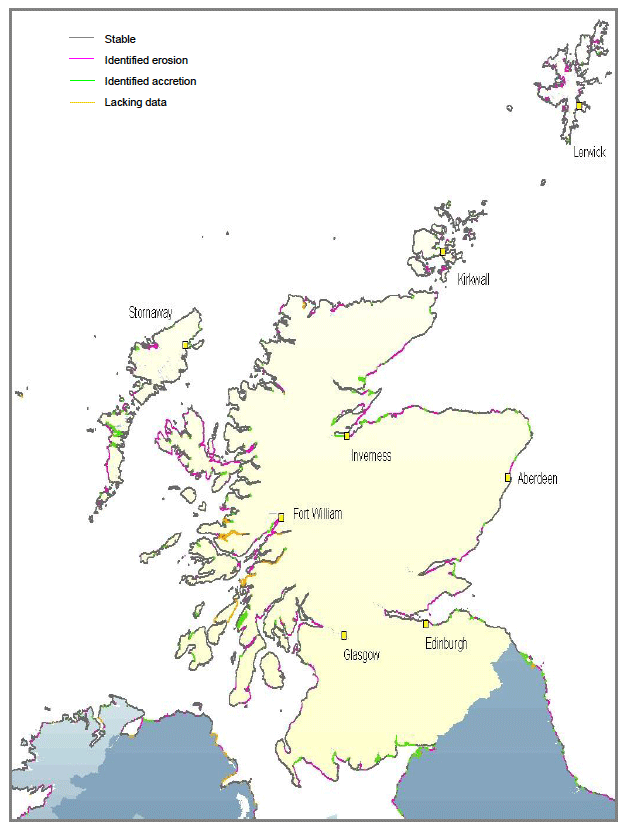
Contact
There is a problem
Thanks for your feedback
